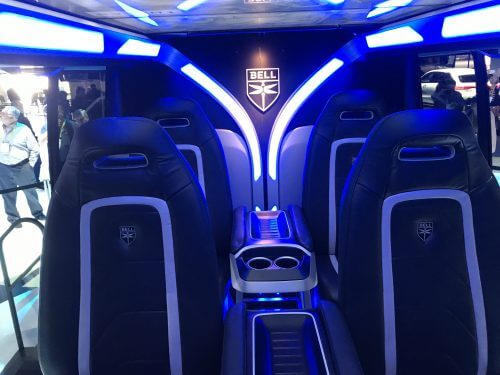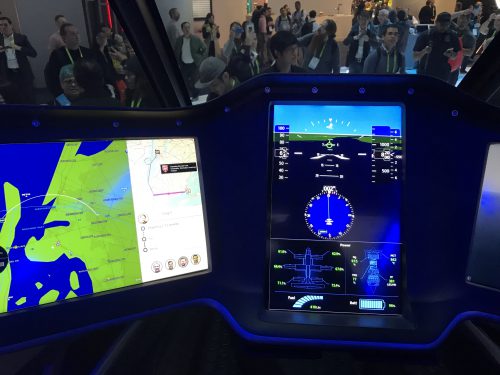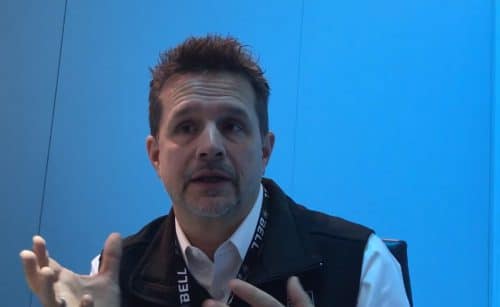This is what he says in an interview with the scientist website with Scott Drennan, vice president of innovation at the helicopter manufacturer Bell. The interview took place during the CES exhibition

Bell's flying taxi was one of the prominent attractions at the CES conference held at the beginning of the month in Las Vegas.
It turns out that the developments in the field of the autonomous vehicle, and the electric drive also reach the sky. Even if the result is much clumsier than the Heid Lorian in the film series Back to the Future, we are about to discover the third dimension in traffic.
Scott Drennan, vice president of innovation at Bell helicopter manufacturer, explains in an interview with the science website at the company's booth at CES: "We announced the Bell Nexus, a helicopter designed to be used as an air taxi. It is the cornerstone of our on-demand mobility philosophy. It is designed to fly humans, but there are also versions of autonomous helicopters for the field of logistics that are able to transport equipment from place to place, including military equipment."
"As we can see, the rotors of the helicopter are covered for safety purposes. Each aircraft has six rotors, each 8 feet (2.44 meters) in diameter. The rotors also spin much more slowly than in traditional helicopters, to reduce noise. The idea was to develop a helicopter that is much more accessible to customers who are not used to using helicopters."

How much will a helicopter/flying car cost?
Darnan: "We don't know yet, but in any case the cost will be divided into two - purchase cost and operational cost. We are trying to lower both, but mainly the direct operating cost. One of the ways is to bring the tool to the ability to fly 2,000 hours a year, a much higher figure than is accepted in the helicopter market."
"Maintenance of a helicopter currently costs about 50 dollars per year. Since the Nexus is based on an electric drive system, it can be maintained simply by removing and replacing components such as batteries, electric motors, and more. There will be no need for the complex treatments that every helicopter today requires. Reducing the cost of maintenance allows us to talk with companies like Uber, which will make it possible to fly a helicopter on part of the road section, in fact it will be an air taxi, and thus it will be possible to use the helicopter much more."
Will the flying taxi be autonomous or will we still need a pilot?
"Technology makes it possible to manage even without pilots, but the authorities and customers (passengers) will be afraid to adopt a fully autonomous flying vehicle, even less than an autonomous car that will drive on the road. Our system is designed to be autonomous from the start, initially there will be a pilot on board, but when people feel comfortable it will be possible to fly in a completely autonomous way."
"Today, people who go to work in big cities spend an hour or even two hours on the roads, especially in cities like Los Angeles, Beijing or New York. It will be possible to live further away but also save precious time that can be freed up for other needs, for example family and friends."
Will it be possible to fly directly from point to point, or only between landing sites?
"The system is based on movement between airstrips, but when the passenger orders a ride on the Uber or similar app, it will offer him a segment that includes a ride by ground vehicle to the airstrip, change to the air taxi, and continue to his destination from the airstrip closest to his home. Of course, this service will be more expensive than traveling by car, but faster, the apps will offer all the options, and the user will decide what he prefers to save - cost or time. The app will be able to calculate the price by itself."
Assuming that you and your various competitors will succeed and there will be many flying taxis, how do you prevent traffic jams in the air?
"The attacking flying car is surrounded by sensors that will allow it to know where other flying vehicles are and to synchronize with them. There will also be height separation between the different routes. We are going to utilize the third dimension which is much greater than what can be provided by ground vehicles. "


According to Darnan, it will be necessary to upgrade the airspace management system, although in the first stage it will be possible to rely on the systems that exist today of the Federal Aviation Authority. Drennan adds that Beret Bell is undergoing a cultural transformation from a product-based system to a service-based system. We present in the booth a simulation of such a flight in three different scenarios, to get feedback from the public.
More of the topic in Hayadan:
